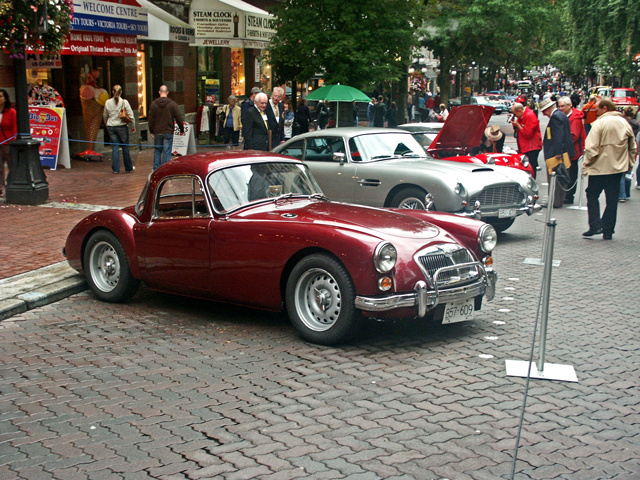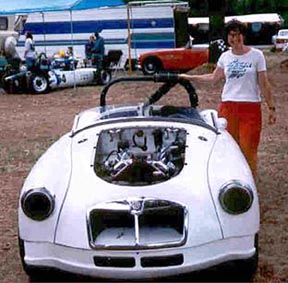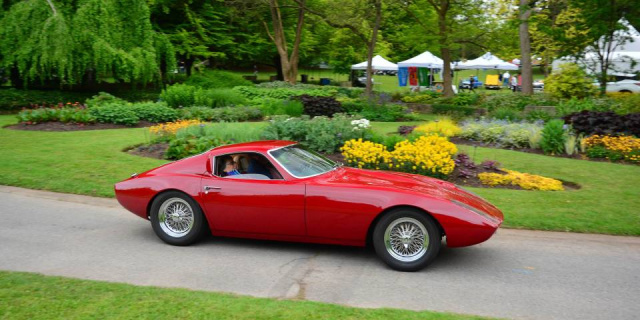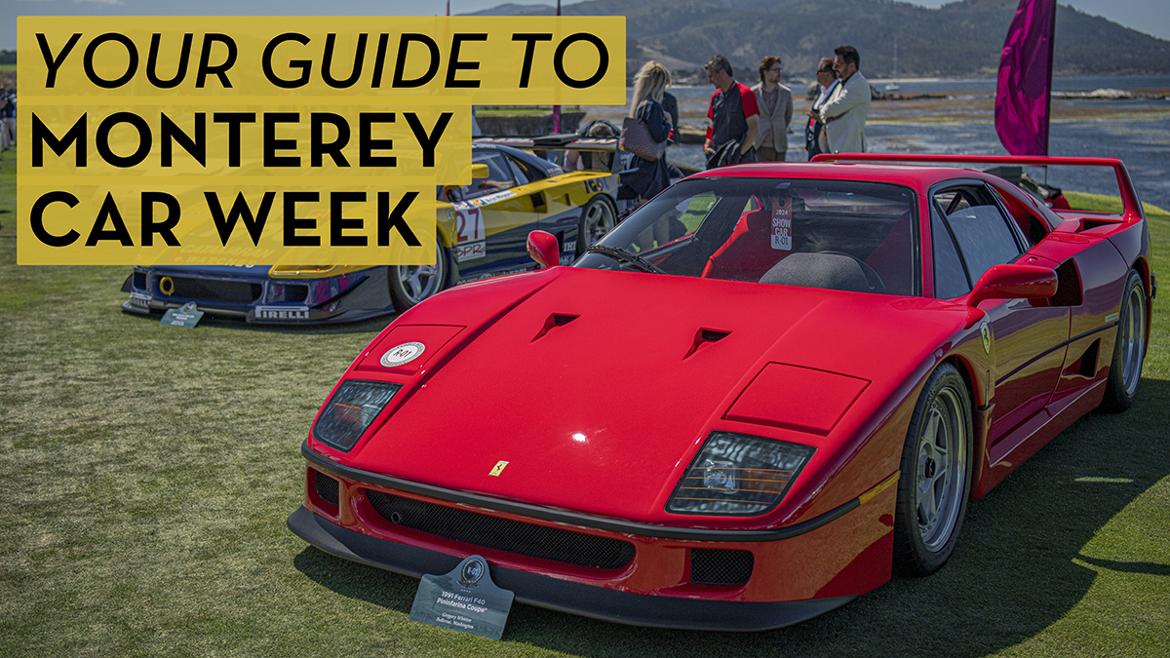Words by Carl Heideman & David S. Wallens
The MGA.
Cool. Classic.
Good enough for Elvis.
And a bit of a trendsetter, too.
Could you call it the first British roadster with Jet Age styling? MG released the MGA late in 1955.
A Triumph from the same era? Shaped more like a bulldog.
The Jaguar E-type? Not sold until the next decade.
The MGA offered more than sleek lines. It was one of the first high-volume production cars to offer four-wheel-disc brakes and a twin-cam engine as an option.
The body featured aluminum doors, trunk lid and hood. There were no exterior latches anywhere on the car. The steering wheel was mounted on an adjustable, telescoping column to maximize driver comfort. For 1956, this was the sports car of the future.
But its drivetrain was derived from other cars in the British Motor Corporation empire and picked for cost, not for performance. As a result, it was nimble but not particularly fast. It was somewhat cramped. And its floorboards were made of wood. Not fancy wood. Plywood.
The double-wishbone, coil-sprung front suspension with rack-and-pinion steering had been designed by Alec Issigonis (of Mini fame) back in 1938. The rear suspension was a conventional solid axle hung on parallel leaf springs.
Do any of those concessions matter today? No, not really. No longer does the MGA need to satisfy shareholders. Today, it represents a fun, rewarding car that immediately transports its occupants to a time of cat eye sunglasses and slicked-back locks.
MGA Practical Guidance
Carl Heideman
Eclectic Motorworks
Common red flags of rust issues are poor door and fender fit, doors that pop open, and doors that don’t close easily. It’s also common to find poorly repaired collision damage at the front of the car; look between the radiator and grille for evidence. Stay away from cars that need repair, and work with someone who has experience with MGAs if you’re going to hire help.
Even MGAs with solid bodies can have issues with doors not shutting properly or latches popping loose over bumps. While the factory pieces can be repaired, it’s usually easier to replace the latches and strikers with new parts.
The MGA chassis is very robust and holds up well to collision damage. A sacrificial, replaceable front chassis extension usually takes the brunt of an impact. Inside frame rails often rust, but the chassis is strong enough that it rarely loses its shape. These rails can be welded very successfully, and repair parts are readily available. The battery tray is the area most prone to rust; again, repair parts are readily available, although not all of them are of the highest quality.
MGAs allow for a lot of parts swapping. For instance, early drum-brake examples can upgrade to discs from later cars or even MGBs. Engines, too, can be transplanted from other MGAs as well as MGBs. Anti-roll bars, rear axles and many other components are also interchangeable.
The downside of this ability to mix and match parts so easily? Some cars are not what they appear to be. It’s worth hiring an expert to help identify the parts in a particular MGA. Values seem pretty much unaffected by this parts trading–except when it comes to the rarer Twin Cam models.
MGAs have straight-cut first and reverse gears with no synchronizers. As a result, they should never be put into first gear while moving. The synchronizers for the upper gears are brass and do tend to wear, especially second gear. Treat the gearbox with respect, however, and it will prove to be very robust.
MGAs have wooden floorboards that actually age very well. The most common problem area is under the driver’s seat. If the driver is heavier than a jockey, the aged board will sometimes sink too close to the exhaust system and occasionally even catch fire.
Running Changes
1955: MG releases the follow-up to its T-series roadsters, a car dating back to before the war, with the low-cut MGA Roadster. Power comes from the brand’s 1489cc inline-four to the tune of 68 horsepower.
1956: MG adds a coupe to the MGA lineup. In addition to the enclosed bodywork, it also sports external door handles.
1958: MG replies to demands for more power with the optional Twin Cam variant, its 1588cc engine making 108 horsepower. Paired with the new engine: four-wheel discs.
1959: Updated engine specs for the standard car warrant an updated name as well. MG welcomes the MGA 1600, with 79.5 horsepower coming from the single-cam 1588cc. Front disc brakes also become standard.
1960: After only about 2000 deliveries, the Twin Cam option is pulled from the lineup due to too many terminal engine issues–maybe blame the day’s gas. Leftover Twin Cam chassis, complete with the four-wheel-disc brakes, could be paired with the standard engine to create what is now called the Deluxe model. (Back then, as legend goes, this pairing didn’t have a special name.)
1961: Late this year, MG improves the cylinder head and ups displacement to 1622cc to create the 90-horsepower MGA 1600 Mark II. That same year, Elvis Presley croons from a red MGA roadster in “Blue Hawaii.”
1962: After delivering about 100,000 units, MG says goodbye to the MGA as the MGB is about to hit the floors.
Comments

wspohn
UltraDork
2/25/25 12:05 p.m.
I've owned many MGAs and still have three - a Mk 2 coupe, a Jamaican bodied 1500 with GM 3.4 driveline, and my old Twin Cam race car.
If you are after sunny day fun, the roadster is the way to go, but for long distance or inclement weather, the coupes are a much better choice - much more modern in concept. I have driven to meets in my coupe with a bunch of roadsters and those guys were all tired out and wind beaten at the end of the run while me and the other coupe owners were still fresh.
They handle better than the Triumphs, though having less power and are less expensive than the big Healeys.



Is there a good buyers guide for the MGA?
What wheel options were available, what years?
How many left hand drive and how many right hand drive were produced?
How many coupes were made?

wspohn
UltraDork
6/6/25 10:17 a.m.
There is lot of info here - https://www.mg-cars.org.uk/mga.html
The MGA was available with either steel or wire wheels, except the Twin Cams, which had knock off steel wheels (see the picture of my coupe, above.
In reply to wspohn :
Thank you. I thought I should have just responded to your post instead of posting my own.
I've driven a couple of different ones a coupe and a roadster. I do like the coupe but I don't see them come up for sale as often or as reasonable.

wspohn
UltraDork
6/8/25 9:59 a.m.
There were fewer coupes made. I prefer them for cross country trips as you can drive 500 miles and get out fresh while the roadster drivers crawl away to their rooms to recover from a day of being wind beaten. Sadly, I am going to be selling my coupe as a double knee replacement makes getting out of the car difficult.
Displaying 1-5 of 5 commentsView all comments on the CMS forums
You'll need to log in to post.

































